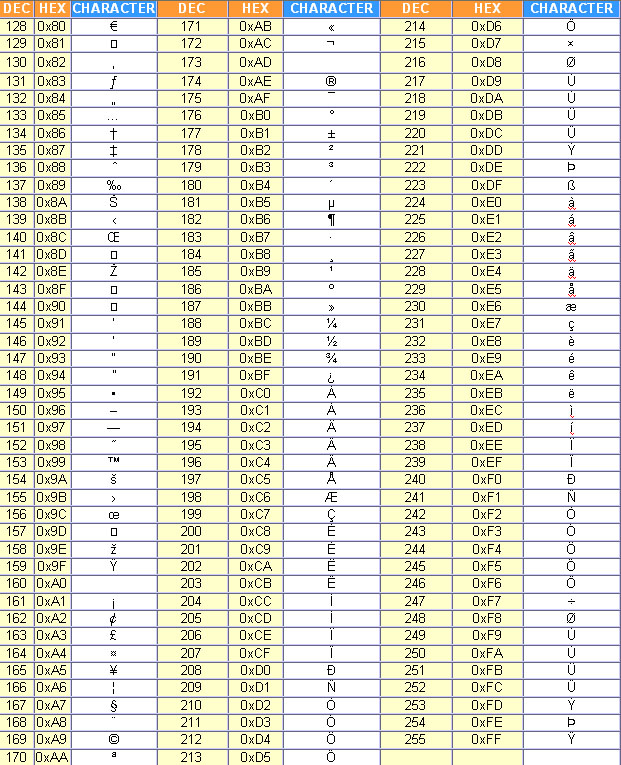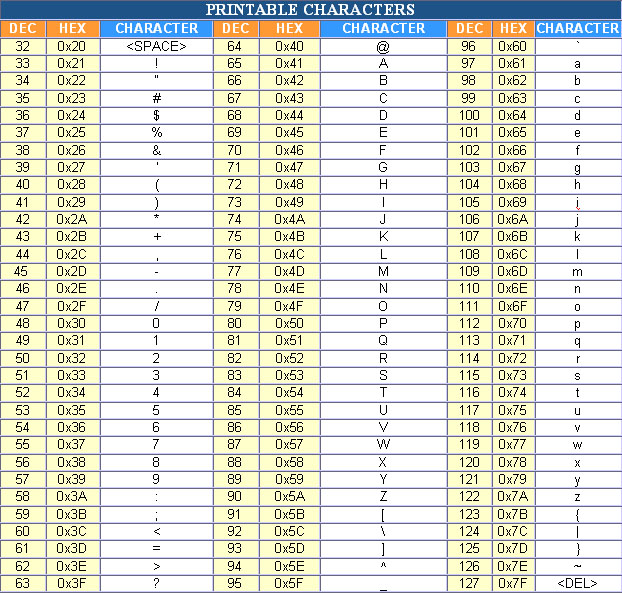Hey there! Today, let’s dive into the fascinating world of ASCII characters. You may have come across ASCII characters while coding or working with text files. ASCII, short for American Standard Code for Information Interchange, is a character encoding standard that assigns unique numeric values to 128 different characters, including letters, numbers, punctuation marks, and control characters.
Non-Printable ASCII Characters
 ASCII characters can be broadly classified into two types: printable and non-printable. Printable ASCII characters are those that can be displayed and printed, such as alphabets, numbers, and symbols. However, there is another intriguing aspect of ASCII characters - the non-printable ones.
ASCII characters can be broadly classified into two types: printable and non-printable. Printable ASCII characters are those that can be displayed and printed, such as alphabets, numbers, and symbols. However, there is another intriguing aspect of ASCII characters - the non-printable ones.
Non-printable ASCII characters, as the name suggests, cannot be displayed or printed as visible characters. These characters have specific control functions and are primarily used to perform various tasks, such as controlling hardware devices, handling text formatting, and controlling the transmission of data.
The non-printable ASCII characters include control characters like carriage return (CR), line feed (LF), tab(TAB), backspace (BS), and many others. These characters are represented by their unique ASCII codes, which are integers ranging from 0 to 31 and 127.
The ASCII Table
 Understanding the ASCII table is essential when working with ASCII characters. It provides a comprehensive list of all the ASCII characters along with their corresponding decimal, hexadecimal, and binary values. This table acts as a reference guide, enabling programmers and users to interpret and manipulate ASCII characters effectively.
Understanding the ASCII table is essential when working with ASCII characters. It provides a comprehensive list of all the ASCII characters along with their corresponding decimal, hexadecimal, and binary values. This table acts as a reference guide, enabling programmers and users to interpret and manipulate ASCII characters effectively.
Let’s take a closer look at some commonly used non-printable ASCII characters:
- Carriage Return (CR): Character code 13 or ‘\r’. When encountered, it instructs the cursor to move to the beginning of the current line.
- Line Feed (LF): Character code 10 or ‘\n’. It moves the cursor to the next line.
- Tab (TAB): Character code 9 or ‘\t’. It inserts a horizontal tab and moves the cursor to the next tab stop.
- Backspace (BS): Character code 8 or ‘\b’. It moves the cursor one position back, allowing overwriting of previously displayed characters.
Why are Non-Printable ASCII Characters Actually Printable?
 Stack Overflow provides a profound explanation for why non-printable ASCII characters are considered “printable.” Although these characters do not have a visual representation, they are displayed using their escape sequences. Escape sequences are special combinations of characters used to represent non-printable characters and other special characters.
Stack Overflow provides a profound explanation for why non-printable ASCII characters are considered “printable.” Although these characters do not have a visual representation, they are displayed using their escape sequences. Escape sequences are special combinations of characters used to represent non-printable characters and other special characters.
For example, the non-printable carriage return (CR) character is represented by the escape sequence ‘\r’ in programming languages. Similarly, the line feed (LF) character is represented by ‘\n’. By using these escape sequences, programmers can work with non-printable ASCII characters in their code and see their effects when running the program.
Wrapping Up
ASCII characters, both printable and non-printable, play a crucial role in various aspects of computing. While printable characters are easily recognizable and displayable, non-printable characters hide behind the scenes, performing important control functions.
Remember, the ASCII table is your go-to guide for understanding and decoding these characters. It allows you to harness the power of ASCII encoding, manipulating text, controlling hardware, and much more.
So, the next time you encounter ASCII characters in your coding adventures, take a moment to appreciate their diversity and importance in the digital world!